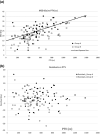Treatment planning and outcomes effects of reducing the preferred mean esophagus dose for conventionally fractionated non-small cell lung cancer radiotherapy
- PMID: 33492763
- PMCID: PMC7882106
- DOI: 10.1002/acm2.13150
Treatment planning and outcomes effects of reducing the preferred mean esophagus dose for conventionally fractionated non-small cell lung cancer radiotherapy
Abstract
Based on an analysis of published literature, our department recently lowered the preferred mean esophagus dose (MED) constraint for conventionally fractionated (2 Gy/fraction in approximately 30 fractions) treatment of locally advanced non-small cell lung cancer (LA-NSCLC) with the goal of reducing the incidence of symptomatic acute esophagitis (AE). The goal of the change was to encourage treatment planners to achieve a MED close to 21 Gy while still permitting MED to go up to the previous guideline of 34 Gy in difficult cases. We compared all our suitable LA-NSCLC patients treated with plans from one year before through one year after the constraint change. The primary endpoint for this study was achievability of the new constraint by the planners; the secondary endpoint was reduction in symptomatic AE. Planners were able to achieve the new constraint in statistically significantly more cases during the year following its explicit implementation than in the year before (P = 0.0025). Furthermore, 38% of patients treated after the new constraint developed symptomatic AE during their treatment as opposed to 48% of the patients treated before. This is a clinically desirable endpoint although the observed difference was not statistically significant. A subsequent power calculation suggests that this is due to the relatively small number of patients in the study.
Keywords: dose-volume constraints; non-small cell lung cancer; normal tissue complications probability; treatment planning.
© 2021 The Authors. Journal of Applied Clinical Medical Physics published by Wiley Periodicals, LLC on behalf of American Association of Physicists in Medicine.
Figures




Similar articles
-
Potential for reduced toxicity and dose escalation in the treatment of inoperable non-small-cell lung cancer: a comparison of intensity-modulated radiation therapy (IMRT), 3D conformal radiation, and elective nodal irradiation.Int J Radiat Oncol Biol Phys. 2003 Nov 1;57(3):875-90. doi: 10.1016/s0360-3016(03)00743-0. Int J Radiat Oncol Biol Phys. 2003. PMID: 14529795
-
Intensity-modulated radiotherapy for locally advanced non-small-cell lung cancer: a dose-escalation planning study.Int J Radiat Oncol Biol Phys. 2011 May 1;80(1):306-13. doi: 10.1016/j.ijrobp.2010.06.025. Epub 2010 Oct 1. Int J Radiat Oncol Biol Phys. 2011. PMID: 20888706
-
Increased therapeutic ratio by 18FDG-PET CT planning in patients with clinical CT stage N2-N3M0 non-small-cell lung cancer: a modeling study.Int J Radiat Oncol Biol Phys. 2005 Mar 1;61(3):649-55. doi: 10.1016/j.ijrobp.2004.06.205. Int J Radiat Oncol Biol Phys. 2005. PMID: 15708242
-
Radiotherapy for lung cancer: target splitting by asymmetric collimation enables reduction of radiation doses to normal tissues and dose escalation.Int J Radiat Oncol Biol Phys. 1999 May 1;44(2):333-41. doi: 10.1016/s0360-3016(99)00021-8. Int J Radiat Oncol Biol Phys. 1999. PMID: 10760428
-
Intraindividual comparison of conventional three-dimensional radiotherapy and intensity modulated radiotherapy in the therapy of locally advanced non-small cell lung cancer a planning study.Strahlenther Onkol. 2002 Nov;178(11):651-8. doi: 10.1007/s00066-002-0939-2. Strahlenther Onkol. 2002. PMID: 12426677
Cited by
-
A Prospective Study on Deep Inspiration Breath Hold Thoracic Radiation Therapy Guided by Bronchoscopically Implanted Electromagnetic Transponders.Cancers (Basel). 2024 Apr 17;16(8):1534. doi: 10.3390/cancers16081534. Cancers (Basel). 2024. PMID: 38672616 Free PMC article.
-
Association of cardiac calcium burden with overall survival after radiotherapy for non-small cell lung cancer.Phys Imaging Radiat Oncol. 2023 Jan 5;25:100410. doi: 10.1016/j.phro.2023.01.001. eCollection 2023 Jan. Phys Imaging Radiat Oncol. 2023. PMID: 36687507 Free PMC article.
-
ROE (Radiotherapy Outcomes Estimator): An open-source tool for optimizing radiotherapy prescriptions.Comput Methods Programs Biomed. 2023 Dec;242:107833. doi: 10.1016/j.cmpb.2023.107833. Epub 2023 Oct 14. Comput Methods Programs Biomed. 2023. PMID: 37863013 Free PMC article.
References
-
- Bradley JD, Paulus R, Komaki R, et al. Standard‐dose versus high‐dose conformal radiotherapy with concurrent and consolidation carboplatin plus paclitaxel with or without cetuximab for patients with stage IIIA or IIIB non‐small‐cell lung cancer (RTOG 0617): a randomized, two‐by‐two factorial phase 3 study. Lancet Oncol. 2015;16:187–199. - PMC - PubMed
-
- Aupèrin A, Le Pèchoux C, Rolland E, et al. Meta‐Analysis of concomitant versus sequential radiochemotherapy in locally advanced non‐small‐cell lung cancer. J. Clin Oncol. 2010;28:2181–2190. - PubMed
MeSH terms
Grants and funding
LinkOut - more resources
Full Text Sources
Other Literature Sources
Medical

